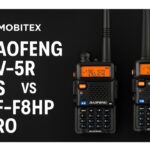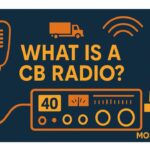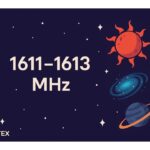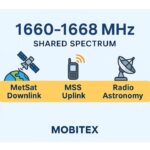The 1428–1452 MHz band sits within the lower L-band, bridging the boundary between the protected radio-astronomy range below 1427 MHz and the active fixed and mobile telemetry allocations above it. It is a crucial slice of spectrum that supports a blend of aeronautical telemetry, fixed-wireless backhaul, and industrial communications.
✈️ Aeronautical and Telemetry Services
Across ITU Regions 1, 2, and 3, the 1428–1452 MHz range is widely recognized as a core telemetry band. In North America it carries flight-test telemetry, transmitting real-time performance data from aircraft and spacecraft to ground control stations. Typical implementations use narrow- or medium-bandwidth FM, FSK, or QPSK links, with EIRP levels around 36 to 55 dBm for outdoor systems.

These operations are highly coordinated because of their proximity to the passive 1401–1427 MHz band, where radio astronomy and Earth-observation satellites listen for extremely weak signals. Filters and guard bands (1–2 MHz minimum) are enforced to prevent interference.
🏭 Fixed and Industrial Wireless Links
In several countries the same band also supports fixed wireless telemetry and utility-monitoring systems—for example, pipeline sensors, electric-grid control, or industrial SCADA nodes. Such deployments typically run at lower power (20–30 dBm indoor) and narrower channels (12.5 or 25 kHz), using licensed or lightly licensed models.
These applications provide reliable, low-latency connectivity (< 10 ms) where other wireless systems may not be suitable due to regulatory or interference constraints.
🩺 MBANS and Experimental Use
Some jurisdictions (notably the U.S.) permit Medical Body Area Networks (MBANS) in this range. These short-range telemetry links support patient monitoring and other healthcare devices under strict coordination rules. The same frequencies are sometimes evaluated for Fixed Wireless Access (FWA) or private-industrial LTE/NR trials, though they remain outside standardized 3GPP bands.
🛰️ Technical Characteristics
| Parameter | Typical Value |
|---|---|
| Wavelength (m) | 0.21 |
| Free-Space Path Loss (10 km) | 115–116 dB |
| Quarter-Wave Antenna Length (cm) | ~5.2 |
| Guardband Requirement | ≥ 1 MHz from 1427 MHz |
| Modulations Used | FM, FSK, 4FSK, QPSK |
| Typical Range | 1–50 km depending on EIRP and antenna height |
🌍 Regional Allocation Summary
| ITU Region | Common Allocations |
|---|---|
| Region 1 (Europe, Africa) | Fixed and mobile telemetry; coordination near 1401–1427 MHz. |
| Region 2 (Americas) | Aeronautical telemetry, fixed/mobile links, MBANS. |
| Region 3 (Asia-Pacific) | Fixed/mobile telemetry, occasional public-safety or industrial systems. |
⚙️ Why This Band Matters
The 1428–1452 MHz spectrum provides a balance between range, bandwidth, and equipment size, making it ideal for telemetry where reliability and spectrum cleanliness are paramount. It continues to serve as a backbone for aviation testing, industrial automation, and specialized research telemetry, while maintaining strict coexistence with neighboring passive scientific bands.




